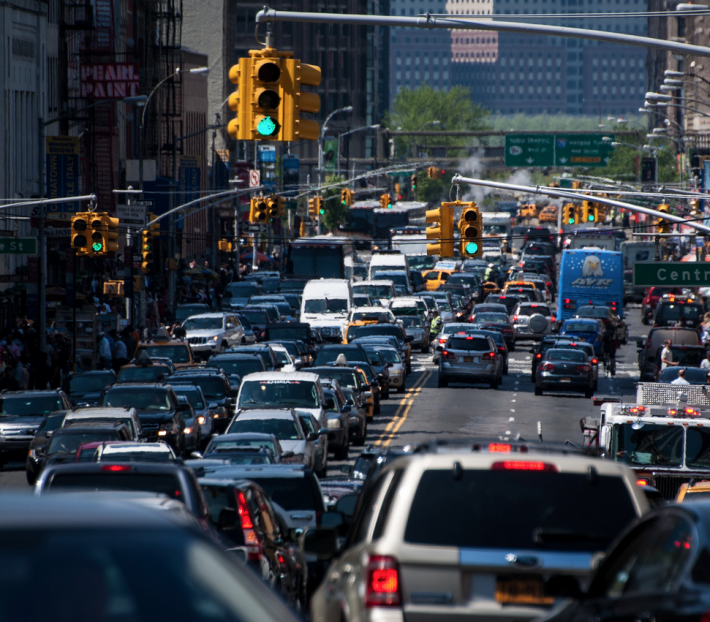The de Blasio administration and the City Council want to slow the growth in new black car licenses over the next year. With companies like Uber adding tens of thousands of black cars to the mix over the past few years, mainly in the most congested parts of Manhattan, the city wants to get a better handle on how the industry is affecting traffic.

“The rate at which new cars are coming on the road is tremendous. I think it’s something we all see traveling around the streets of Manhattan," Taxi and Limousine Commissioner Meera Joshi said on a conference call this afternoon [PDF].
The for-hire vehicle fleet, which includes Uber and other black cars but not yellow or green taxis, has grown 63 percent since 2011. Over the past year, the city issued 2,000 new for-hire vehicle licenses each month, 64 per day. The surge has swelled the for-hire fleet from 38,000 to 63,000 vehicles since 2011. That's 25,000 more vehicles in constant circulation.
Joshi said new app-based services have increased overall demand for car travel, with the growth of for-hire trips outpacing a drop in trips by medallion taxis. "The pie has grown," she said. "The number of people that want to take for-hire vehicles from place A to place B has grown."
While TLC has collected trip data from the city's 13,587 yellow taxis for years, it only began collecting less-detailed information on for-hire trips last year. Crunching the new numbers, the city found that the fastest-growing for-hire companies do 72 percent of their business in Manhattan south of 60th Street.
"What happens to congestion in Manhattan when you start adding lots of new vehicles to the fleet, and they do most of their work in Manhattan?" Joshi asked. "It highlighted some of the negative externalities when we have a concentration of traffic in an already-dense area."
There are early indications that this crop of black cars is making congestion worse. After seeing average speeds on Manhattan streets creep upward in recent years, traffic speeds dropped to 8.51 mph last year, DOT said, a 9 percent decline from 2010. Rush hour MTA buses were also 5 percent slower last year than they were in 2013, DOT said. Manhattan bus ridership has also suffered, dropping 5.8 percent last year.
To get a better handle on the data, the city is proposing to cut down on new for-hire vehicle licenses over the next year while it prepares recommendations to deal with the industry's growth, including potential long-term restrictions on the number of licenses.
Here's how the slowdown will work: New for-hire vehicles must be affiliated with a base. Under the plan, bases with more than 500 or more vehicles will be able to grow by 1 percent over the next year, bases with between 20 and 499 vehicles will be able to grow by 5 percent, and small bases with 19 or fewer vehicles may grow 15 percent over the next year.
The slowdown is necessary "so we’re able to have a clear picture of what it is that we’re studying," said Council Member Steve Levin, who is sponsoring the legislation with Transportation Committee Chair Ydanis Rodriguez [PDF 1, 2]. “If we didn’t put limits on it, the study would be obsolete by the time it is finished.”
"Part of this study is going to be unpacking what is happening with the congestion. Is it for-hire vehicles? Is it economic growth? Are we doing a lot of construction?” said Transportation Commissioner Polly Trottenberg. "Those are trends where we want to see what’s happening, and they’re clearly related to increased congestion."
City officials seemed most concerned about the impact the slowdown in Manhattan vehicle speeds is having on bus ridership and air quality. Asked if the study will consider congestion pricing, Trottenberg said it is "not part of what we’re talking about today." Also not mentioned: the impact of the black car industry on street safety and Vision Zero.
Joshi said TLC has begun working with DOT and the city's Department of Environmental Protection on the study. Joshi pointed out that London is considering its own curbs on for-hire vehicles. Earlier this year, the Committee for Taxi Safety, which is affiliated with medallion owners, proposed a cap on the number of for-hire vehicle licenses.
Not surprisingly, Uber blasted the city's plan. "Three months ago, the taxi industry put forward a proposal to protect the status quo, and limit competition and innovation. Today, the de Blasio administration and City Council members revived a nearly identical proposal," said spokesperson Matt Wing. "Unfortunately, this would reverse improvements made by Uber and others to our transportation system and most notably, stand between New Yorkers looking for work and their opportunity to make a better living.”
An earlier version of this story said 72 percent of FHV trips originated in an area south of E. 96th and W. 110th streets. That percentage of trips actually originate south of 60th Street. The story has been corrected.





